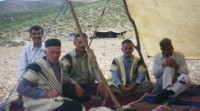
Photo. The Bakhtiaria are called the People of the Wind.
Some of the nomadic groups in Iran are known as Turkmen, Shahsavans, Lurs, Bakhtiaries, and Qashqaies. All these groups had a tribal structure with some living in villages and others partly migrating. Tribe people in Iran refer to the villagers as "land-bound" and call themselves "People of the Wind". The Bakhtiari are Shiite Muslims and are famed for their courage and independence, but also for their great hospitality.
Photo. Bakhtiari nomads live
high up in the mountain hillsides. The scenery with snow capped summits in the
background was something for itself!
As the sun lightened up the snow capped mountains in the late morning, I was
walking up a hillside to visit a group from a Bakhtiari nomad tribe in Iran. I
could really feel the heat, and hoped that I would be invited in to a cool tent
for a rest. It didn't take long time before I experienced the nomads' unique
hospitality.
The good smells from the beautiful Shabdar
flowers that grow around created a unique atmosphere. When I approached the
nomads I could see that it started to be activities in the small camps. People
looked curious out from the tents, and some of them come toward me. This was the
start of a real adventurous journey in Iran in July 2004. Both adults and
children welcomed me everywhere I showed up.
See the video clip from the Bakhtiari nomads great hospitality.
COMING UP!
I visited the Bakhtiari nomads in Shahr-e Kord region. The Bakhtiari tribe,
live in Khuzestan Province in winter and immigrate to the altitude of Zagros in
Chahar Mahal Bakhtiari in summers. They migrate in search of water and food for
their animals. Their migration is among the most spectacular known among nomadic
pastoralists anywhere. It is an epic of human courage and endurance in which
men, women and children of all ages, with their animals and household goods,
travel by five different migrations routes across some of the wildest and most
difficult mountain country in Persia in their search for grass.
Photo. The Bakhtiari nomads live in a wild and
harsh landscape, but that didn`t prevent them from smiling.
Many Bakhtiari people still live in black goat hair tents and are nomads. The
Bakhtiari language is part of the Persian family of languages and is not
Turkic.
The group can be divided into two large branches, the Haftlang, with about 55
tribes, and the Charlang, with about 25 tribes.
They make colourful hand-woven crafts, each symbolizing a tribe's colour, its
land and myth in the design. The patterns they use to weave their rugs are
handed down from generation to generation, and they still use the old method of
processing the natural dyes.
In Iranian mythology, the Bakhtiari consider themselves to be descendants of
Fereydun, a legendary hero from the Persian national epic, Shahnameh.
There are over one hundred different nomadic tribes in Iran today, each with
its own dialect, style of dress and housing, and its own chief or leader. The
largest tribal groups are the Kurds, who live in the province of Kurdestan in
the northern Zagros region, the Lurs and the Bakhtiari, who live in the southern
Zagros region, the Qashqai in Fars, the Turkoman in the northeast, and the
Baluch in the southeast.
The Bakhtiari nomads retain its traditional lifestyle and
culture
The Bakhtiari nomads, which numbered more than 1
million in 1997, inhabits an area of approximately 67,000 Km (25,000 Mi) that
straddles the central Zagros Mountains. They speak a dialect of Persian called
Lori (Luri), and are Shiite Muslims. About one third of the tribe is nomadic.
The last chieftain (Khan) of the Bakhtiari tribe was Jafar Gholy, whom
died 2003.
Iran has many unique features of its own in its people, landscapes, arts
and customs. One of the things I found most interesting on my journey in this
country was the nomads. They were really great!
Stein Morten Lund, 24 March 2006
Additional information
Read more articles
and view more video clips about nomads in Iran and other interesting articles
about Iran on our website Travel Explorations.
Facts about Iran:
Formal country name: Islamic Republic of
Iran.
Area: 1.64 million sq km.
Population: 68.27 million.
People:
Persian (Farsis) (65%), Azari (25%), Arab (4%), Lors (2%), Turkmen (2%),
Kurdish, Armenian, Jewish.
Language: Persian, Kurdish.
Religion: Shi'ite
Muslim (89%), Sunni Muslim (10%), Zoroastrian, Jewish, Christian, Baha'i
(1%).
Government: Islamic republic.
Movie about the nomads:
Milestone Film & Video presents
A f
i l m b y A n t h o n y H o w a r t h
PEOPLE OF THE WIND
The Chronicle of a Nomadic
Chief
There are two
hundred miles of impassable mountains to cross.
There are no towns, no roads,
no bridges.
There is no turning back.
Featuring the
voice of James Mason
Academy Award® Nominee: Best Documentary
Golden
Globe Nominee: Best Documentary
A Milestone Release
PO Box
128
Harrington Park, NJ 07640
Phone: (201) 767-3117
Fax:
(201) 767-3035
Email: milefilms@aol.co
www.milestonefilms.com





 Photo. The Bakhtiaria are called the People of the Wind.
Some of the nomadic groups in Iran are known as Turkmen, Shahsavans, Lurs, Bakhtiaries, and Qashqaies. All these groups had a tribal structure with some living in villages and others partly migrating. Tribe people in Iran refer to the villagers as "land-bound" and call themselves "People of the Wind". The Bakhtiari are Shiite Muslims and are famed for their courage and independence, but also for their great hospitality.
Photo. Bakhtiari nomads live
high up in the mountain hillsides. The scenery with snow capped summits in the
background was something for itself!
Photo. The Bakhtiaria are called the People of the Wind.
Some of the nomadic groups in Iran are known as Turkmen, Shahsavans, Lurs, Bakhtiaries, and Qashqaies. All these groups had a tribal structure with some living in villages and others partly migrating. Tribe people in Iran refer to the villagers as "land-bound" and call themselves "People of the Wind". The Bakhtiari are Shiite Muslims and are famed for their courage and independence, but also for their great hospitality.
Photo. Bakhtiari nomads live
high up in the mountain hillsides. The scenery with snow capped summits in the
background was something for itself!






